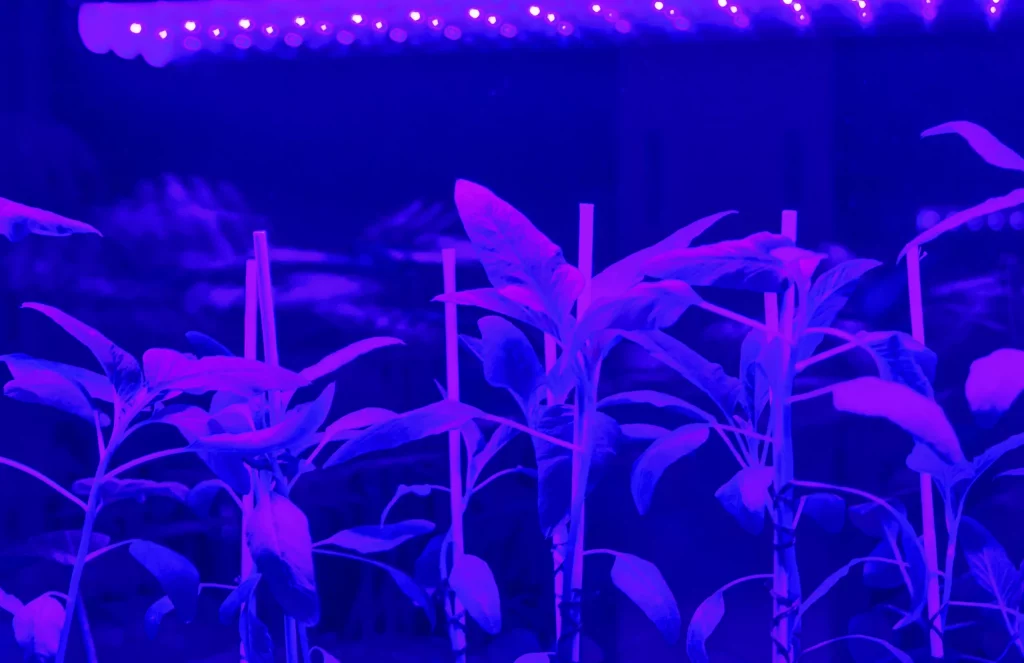Monitoring of photosynthesis can prevent ecological disasters

The analysis of chlorophyll fluorescence enables us to monitor the needs of plants, says Prof. Hazem M.Kalaji, Institute of Biology, SGGW. Professor Kalaji developed a system for monitoring the condition of plants. The “Greenhouse silent disco” installation at the Milan Triennial was inspired by the research of Professor Hazem Kalaji. Professor Kalaji has been studying photosynthesis for 40 years; the most important process for plants, humans, and animals.
Measuring chlorophyll fluorescence allows us to monitor the needs of plants, says Prof. Kaleji. Initially, the professor’s team carried out analyses of the photosynthesis process to better understand the response of plants to various stress factors. The discovery of the chlorophyll fluorescence signal was a breakthrough. The signal allows monitoring of the physiological state of all organisms with chlorophyll, i.e., vascular plants, moss, and algae on an ongoing basis. Monitoring is a non-invasive process.
The observation of the fluorescence signal allows us to gain information about the condition of the plant in a short time (one second) and analyze about 60-70 different parameters related to its functioning. It also enables us to identify the type of stressor, e.g. disease, pest, drought, or mineral deficiency. The signal is connected with the Photosystem II protein complex. That is how we can get information from plants similar to human feedback during an ECG, i.e. an analysis of the heart rhythm, to assess the state of our health.
A human heart rate is considered normal if the rate is between 60 and 90 beats per minute, in the case of plants. The maximum quantum efficiency of photosystem II (during the measurement ratio of chlorophyll fluorescence) should be in the range of 0.83-0.85 (parameter: Fv/Fm)., indicating the optimal state of “health” of plants. Any plant disease causes specific changes in the chlorophyll fluorescence induction curve, says Prof. Kaleji. The analysis of the curve helps us determine whether the plant “suffers” from low temperature, salinity, or other stress factors, i.e. unfavorable conditions for growth.
The chlorophyll fluorescence signal is specific in the case of drought, regardless of the species of the tested plant.
ProfessorKalaji points out that the technique of measuring the chlorophyll fluorescence signal offers the opportunity to detect changes in the plant before the symptoms of these changes become visible to the eye. Based on previous findings, the professor developed a system for monitoring the condition of plants, and his team began collecting hundreds of thousands of data to analyze the physiological state of plants and entire communities or ecosystems (such as a forest or meadow). We want to understand the mechanisms of survival, adaptation, and various types of processes that are carried out by plants.
Prof. Kalaji hopes his work will help farmers increase yields.
The point is to better understand why some varieties have a higher yield than others that grow next to them under the same conditions. This is how we identify specific features that can be used by breeders and farmers.
The plant monitoring system can also be useful for wildlife assessment, because “using this signal, plants immediately alert that something is happening to them.” Installing such a system in the forest can help prevent pest infestation before the changes become visible to the naked eye. As an example, the professor mentions the appearance of the European spruce bark beetle in the Białowieża Forest a few years ago.
The scientist adds that measuring the chlorophyll fluorescence signal in the tree leaves every ten minutes would help notice changes and detect the appearance of the first insects. The forester could receive such information along with the location where the change was recorded.
I deal with all ecosystems, including water ecosystems, says Professor Kalaji.
In his opinion, non-invasive monitoring of changes in ecosystems would help prevent many environmental disasters.
As examples, he mentions the poisoning of the Odra River, the pollution of the Wisła River (in connection with the incident at the Czajka wastewater treatment plant) and algal blooms in the Baltic Sea.
Professor Kalaji emphasized that measuring chlorophyll fluorescence helps monitoring of algae in the Baltic Sea and Polish lakes.
If we had such a system of informing about the water changes in the Odra River based on the physiological state of algal photosynthesis, we would get alarmed via mobile phones, informing about those changes. Collecting water samples once a week and analyzing them in the laboratory is not enough, adds Kalaji.
Such technology of monitoring changes by measuring the fluorescence of chlorophyll enables early detection of potential ecological disasters. The best way is to anticipate and locate changes and prevent them.
At the same time, the professor notes that there is not a single eco-friendly ambulance in the entire European Union, i.e., a car equipped with tools for quick monitoring of water, forest, horticultural, and soil ecosystems.
He explains that a whole laboratory could fit in a small truck. A technician could monitor disaster areas and send the data to a science database. Scientists would receive reports from the field and assess whether there is a threat of a catastrophe, e.g. heavy metals, and decide how to handle it.
Professor Kalaji’s studies on the plant monitoring system inspired Michał Duda and Małgorzata Devosges-Cuber from Adam Mickiewicz Institute and the Museum of Architecture in Wrocław who created the “Greenhouse silent disco” installation shown at Triennial, Milan.
The installation takes the form of a plant-filled greenhouse that enables direct contact between people and plants.
It is equipped with digital sensors hooked up to computer systems that monitor and record everything that plants ‘say’, i.e., how they react to specific needs and variables, such as somebody’s presence, or changes in external atmospheric conditions. The ‘language’ of plants will be expressed via LEDs changing colors and sounds transformed by the computer.
Source: Nauka w Polsce